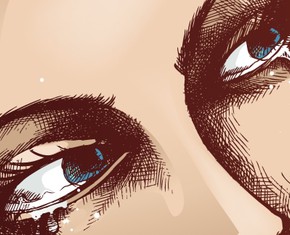The views expressed in our content reflect individual perspectives and do not represent the authoritative views of the Baha'i Faith.
Besides the prayers and meditations of Baha’u’llah, some of his most frequently noted extended metaphors occur in his mystical book The Hidden Words.
The Persian language is, by tradition, a poetic language. This often happens with a language that does not have so rich a vocabulary as English or Arabic. For without words of precision, connotation and imagery enable the speaker to express subtleties. But the fact is that poetic traditions emerge early in the history of a people for reasons that may have more to do with other cultural orientations and less to do with vocabulary per se.
Regardless of the reason, it is enough to note that the Persian-language section of The Hidden Words abounds in imagery. Some of the metaphors are simple and easily understood, though no less powerful because they are accessible:
In the garden of thy heart plant naught but the rose of love, and from the nightingale of affection and desire loosen not thy hold. – Baha’u’llah, The Hidden Words, p. 23.
Other verses in the Persian Hidden Words are long, complex, and extremely abstruse. But almost all illustrate well the importance of metaphor in understanding the many levels of meaning in the writings of Baha’u’llah.
One Hidden Word that is particularly well suited in illustrating the mechanics of metaphor employs an extended image with three main vehicles—a sword, a sheath, and an artificer, or sword-maker:
O My Servant! Thou art even as a finely tempered sword concealed in the darkness of its sheath and its value hidden from the artificer’s knowledge. Wherefore come forth from the sheath of self and desire that thy worth may be made resplendent and manifest unto all the world. – Ibid., p. 47.
Here Baha’u’llah has given us a start by filling in one of the three missing tenors in this equation; he tells us the sheath is “self and desire.” Moreover, since the passage is addressed to a “servant,” we can assume, perhaps, that the sword represents a Baha’i—a follower of Baha’u’llah. We can also assume that the “artificer” is God or the messenger of God—that is, God as Creator or the prophet who has, in effect, recreated us on God’s behalf.
But the equation is still not really solved, because we do not know why the sword, the sheath, and the artificer are compared or what the metaphor is meant to demonstrate, until we consider more carefully the tone and nature of the comparison. The servant is being criticized for remaining in the “sheath of self and desire”—that much we can understand—but why a sword, and a finely-tempered one at that?
A sword, especially when finely tempered, is a practical instrument, a weapon of war. The servants of God are also meant to be practically useful—no longer monks in monasteries, but active in the world, warring against iniquity and injustice. To make themselves known to God, they must act, must use the spiritual perfections that lie dormant.
Here we may be reminded of the many passages that extol the lofty possibilities of the human spirit.
When this potential is manifest in physical action, the spiritual capacity latent within all men becomes “manifest unto all the world.” This is a particularly plausible interpretation since this passage is near the end of the volume, where we find similar exhortations for the “servant” to act:
Ye are the trees of My garden; ye must give forth goodly and wondrous fruits, that ye yourselves and others may profit therefrom. – Ibid., pp. 50-51.
But a more subtle and perhaps more refined interpretation is that the sword represents the tongue and the words it can utter, an image that Baha’u’llah employs elsewhere.
The passage then becomes an exhortation for the believers or followers of the prophet not to keep silent about what they have discovered, but to busy themselves teaching the good news to the rest of humankind, even as Baha’u’llah commands his followers:
Teach ye the Cause of God, O people of Baha, for God hath prescribed unto every one the duty of proclaiming His Message, and regardeth it as the most meritorious of all deeds. – Baha’u’llah, Gleanings from the Writings of Baha’u’llah, p. 278.
Relevant to our previous discussion, however, is the continuation of this exhortation in which Baha’u’llah states that such teaching will have no effect unless the teacher manifests the truth of his utterance in his own actions:
Such a deed is acceptable only when he that teacheth the Cause is already a firm believer in God, the Supreme Protector, the Gracious, the Almighty. He hath, moreover, ordained that His Cause be taught through the power of men’s utterance, and not through resort to violence. – Ibid.
These images from The Seven Valleys, the morning prayer, and The Hidden Words only convey a few examples of the infinite variety of uses of metaphorical language found in the writings of Baha’u’llah, each with its own possibilities for meaning. Not that we need become students of literature or poetry to understand or appreciate the writings of Baha’u’llah—but we must have something of a poetic soul to grasp the inner essence of what the prophet means, if by “poetic” we mean the capacity to “see with thine own eyes and not through the eyes of others.” – Tablets of Baha’u’llah, p. 36.
















Comments
Sign in or create an account
Continue with Googleor